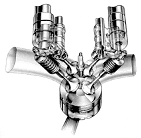

Structure
Body Refinement
The Integra features a number of innovations that improve performance,
durability and safety. For starters, the Sports Coupe provides 298.9
degrees of visibility. The Sports Sedan provides 306.3 degrees of
visibility. The beneficial impact of all-around visibility on safety is
self-evident.
To reduce wind noise and enhance aerodynamic efficiency, the Sports Coupe
uses a pin-guide sash system for the door glass. The pin holds the window
captive against the sash and forms a tighter seal than conventional
designs.
Front & Rear Crumple Zone

At the front and rear the body is designed with deformable crumple zones.
In a collision, these zones absorb impact energy and help prevent
deformation of the passenger compartment.
In addition, all Integra models are equipped with a driver and front
passenger dual air bag Supplemental Restraint System. The air bags are
designed to work in conjunction with the 3-point outboard seat belts.
Chassis
Four Wheel Disc Brake & ABS
All Integra models feature 4-wheel disc brakes with ventilated front
rotors to aid in rapid heat dissipation. To provide a short pedal stroke
the front brake calipers are stout units that have a higher resistance to
flexing and "spread" under severe brake application.
The Integra LS, GS and GS-R feature a standard Anti-Lock Braking System
(ABS) to help the driver retain steering control under maximum braking
effort.
Front & Rear Suspension
To complement the advanced powertrain, Integra has an equally
sophisticated suspension system. The front and rear suspension of all
Integra models features an upper and lower control arm layout with
stabilizer bars and a coil-over shock absorber. Like some of the key
engine technology, the suspension design is derived from Formula One
racing.
To add an extra measure of precision, the GS and GS-R models feature a
stabilizer bar equipped with ball joints instead of rubber bushings. The
GS-R model also features a shock tower bar to stiffen the lower subframe
in order to enhance rigidity. This translates into sharper handling
response.
Torque Sensitive Steering Gear
Rather than a conventional power steering system that uses vehicle speed
to determine the amount of steering assist, the Integra system uses a
combination of engine rpm and the amount of torque generated between the
tire and the pavement. This provides a more linear power assist program
and exercises more precise control over the amount of assist provided.
Powertrain
Engines
The core of the Integra personality lies in the engine. Like all Acura
engines, this engine is all-aluminum with steel cylinder liners for
durability. In the RS, LS and GS models the 1.8-liter engine produces 140
hp and 127 lbs-ft of torque and it features 4 valves per cylinder and
dual overhead camshafts.
The GS-R engine adds the Variable Valve Timing and Lift Electronic Control
(VTEC) system to the basic DOHC architecture. In this configuration, it
produces 170 hp and 128 lbs-ft of torque.
VTEC

The Variable Valve Timing and Lift Electronic Control (VTEC) system solves
the age-old trade-off between tuning an engine for high speed power
output or low-speed speed torque and responsiveness. Until Honda
engineers developed VTEC an engine could have one or the other. But not
both. But VTEC has rewritten the rules.
Using a unique arrangement of three cam lobes and three corresponding
rocker arms for each pair of valves, the VTEC system can alter not just
valve lift, but valve timing as well in response to engine load and
driver demand. VTEC operates on intake as well as exhaust valves.
The crossover point between nominal valve lift and high valve lift occurs
at 4400 rpm. As the engine continues to rev beyond that point, another
system comes into operation - the dual stage intake manifold. At 5800
rpm, a second intake runner in the dual stage manifold opens to fully
exploit the additional breathing potential of VTEC. Thanks to these two
complementary systems, the GS-R engine has and almost flat torque curve
from 2500 rpm up to 7200 rpm.
This is a truly remarkable engine. It has the highest specific output per
liter of displacement than any normally aspirated engine on the market.
And it also has the highest piston speed of any automobile engine in the
world, even faster than the World Championship Honda Formula One engines.
Electronic Four Speed Automatic Transmittion
The optional 4-speed automatic transmission is available in RS, LS and GS
models. It features an ignition retard system to reduce shift shock and a
low-hold feature to enhance performance on driver demand. In addition,
it features the Grade Logic Control System. This system uses a
microprocessor to estimate the grade of a hill. It does this by measuring
the vehicle speed and the throttle angle and compares these parameters to
those stored in a "map" in the electronic control unit. The system either
allows the transmission to shift to a higher gear or hold it in a lower
gear to achieve the smoothest operation. On downhill grades it holds the
transmission in a lower gear to enhance engine braking.





